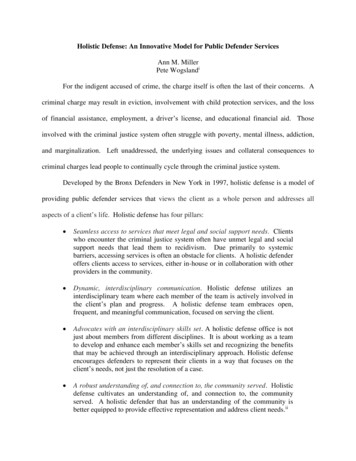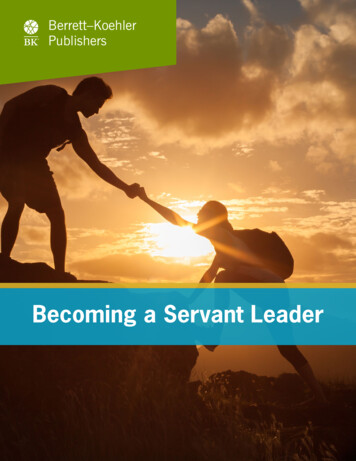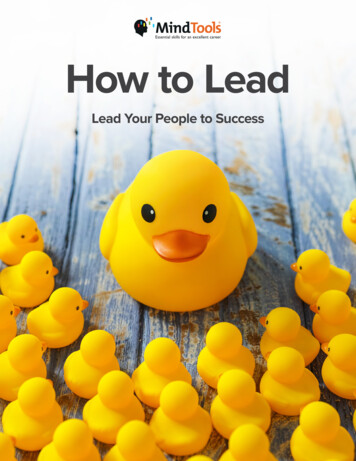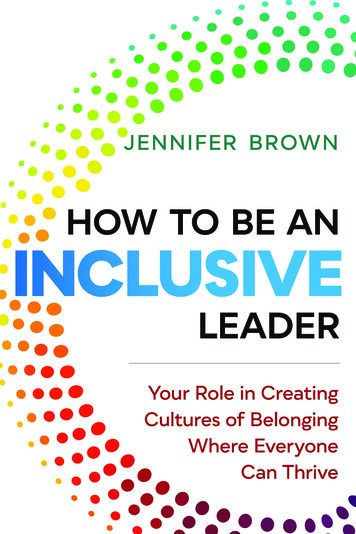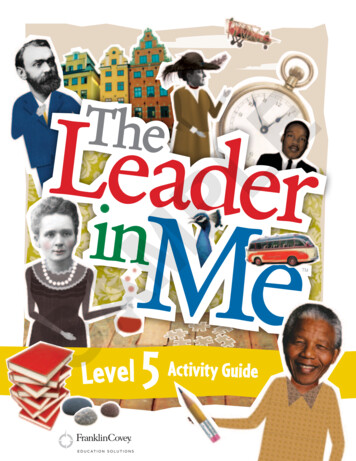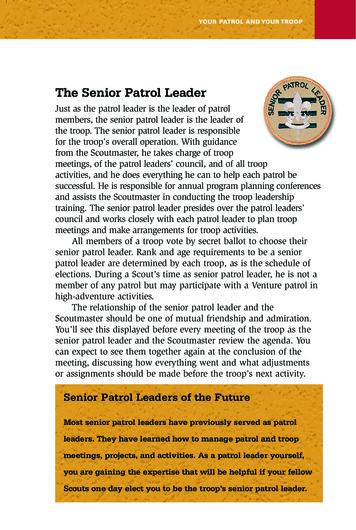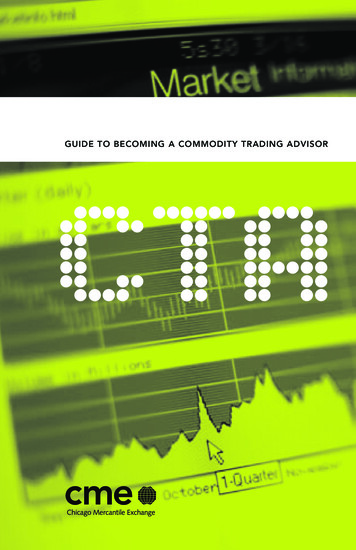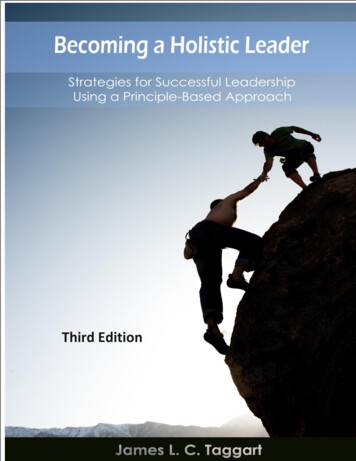
Transcription
Third Edition
CoverSpecial thanks to Aaron Curtis McLean for the cover design.Notice of RightsAll rights reserved. No part of this book may be reproduced, stored in a retrieval system, or transmitted in any formor by any means without the prior written permission of the author, with the exception of brief quotationscontained within articles or reviews. Address inquiries to James Taggart: jim.taggart@rogers.comCopyright 2010, 2011, 2016 James L. C. TaggartP a g e i
Becoming a Holistic LeaderLeaders need to create a safespace to foster collaborativeinquiry, creativity andinnovation.James TaggartP a g e ii
Becoming a Holistic LeaderDedicated toTo Lily, Ashley, Briar, Ethan and LoganAs you grow, may you find your leadership within and share with the world.P a g e iii
Becoming a Holistic LeaderTable of ContentsPagePrefaceviForewardviiIntroductionix1 – A Personal Reflection12 – Setting the Stage43 – Personal Principles – the Guiding Light74 – The Right-Hand, Left-Hand of Management and Leadership155 – Holistic Leadership236 – Teaching287 – Directing328 – Participating369 – Nurturing4010 – 10 Valuable Lessons for Aspiring Holistic Leaders45P a g e iv
Becoming a Holistic Leader11 – Finding Your Own Voice48About the Author51Acknowledgements52Appendices55Questions for Reflection and Inquiry5610 Ways to Earn Respect as a Leader in the Workplace59Recommended Leadership Books61Web Site Resources63References64P a g e v
Becoming a Holistic LeaderPrefaceA lot has happened around the world since the first edition of Becoming a HolisticLeader was released seven years ago. The international financial system teeteredon collapse, the Great Recession exerted pernicious effects (which still linger) andthe globalization of work and technology continue their relentless march forward.In 2011, turmoil exploded in many countries in the Middle East and North Africaas citizens took to the streets to demand meaningful change from their nationalgovernments. Self-empowerment in action. Yet within a few years hope turned todespair and fear, witnessed by repressive government actions and the rise of ISIS.I’m not a purveyor of the future; indeed who is? As with this e-book’s first edition,my primary aim in this third edition is to assist you surf the waves of change andto respond quickly to new trends. Above all, I want you to embrace change; fearshould be replaced with enthusiasm and curiosity. Seek out and explore theopportunities.I’ve gone through one major change since first writing this e-book. After threedecades of working for the Government of Canada, I retired in December 2010. Itwas an easy yet difficult decision. Easy, because I had grown weary of the inertia,turf protection and lack of focus on serving citizens. Difficult, because I would beleaving a secure job and venturing out into the unknown. Since then, I’ve donecontract research, and more recently work part-time in outdoor gear retail, whichfits my love for the outdoors. I began my working career in consumer lending in1978, and now have returned full-circle to serving others.I take pride and enjoyment that Becoming a Holistic Leader has been read arounda large part of the world: from Malaysia and Australia to North America to theUnited Kingdom, Europe and Africa.Thank you for your feedback, loyalty and trust.Jim TaggartOttawa, Canada, March 2016P a g e vi
Becoming a Holistic LeaderForewordI have known Jim Taggart since 1998. We met during our two-year learningjourney at Royal Roads University while completing our Masters degrees inleadership. Jim always struck me as a pattern thinker and someone who couldcapture the essence of his thinking in a few words. He enjoyed writing histhoughts and shared them broadly and generously. In fact, I still have on mycomputer from those many years ago a folder called Jim’s Writing.I have followed Jim’s career, thoughts and writing and his current blog, ChangingWinds. He takes the initiative to stretch and learn and dig deep into the leadershipthought literature. As an author of two books and over 25 curriculum publicationsmyself, I am deeply honoured to write this foreword to give you some insight intoJim’s new e-book, Becoming a Holistic Leader.Jim expresses his leadership through his writing in a friendly open style thatencourages the reader to continue reading on. In Becoming a Holistic Leader wesee snippets and stories of Jim’s life; we see his leadership journey and struggles,his thinking and, above all, he shares with us his philosophy, the Holistic LeaderModel, and ten personal principles by which he lives his leadership.Jim tells us his model is a “culmination of how leadership and management shouldbe combined together as an integrated practice” and is founded upon the premisethat each of us must strive throughout our lifetime to “become a balanced,centered individual who is able to effectively use the four principal components ofleadership: teaching, directing, participating and nurturing.”Jim’s model resonates well with my knowledge and study of leadership. He givesus much to think about with strong leadership quotes, personal leadership storiesand reflection, and, as usual for Jim, strong reference to the leadership literatureto support his thinking. The essence of his suggestion that each of us “must stepup to the plate and exercise our own leadership in order to contribute to buildinga better society” is a critical call to action for leaders at all levels today. We needto effectively lead ourselves out of the mess we have created on this planet, andP a g e vii
Becoming a Holistic Leaderthis takes shared leadership. We need to find within ourselves the answers to thequestions we are almost afraid to articulate.Becoming a Holistic Leader provides us with not entirely new thinking, but rather afresh look at the value and importance of integrating management and leadershipso that they work synergistically together. Jim’s principles are deeply personaland he openly shares them with the reader, not so much that you will adopt themor consider them the principles to follow, but rather to reflect upon and thinkabout them and to spur you to action to examine and articulate the principles youhold to be true for you. Having principles, as Jim says, is a guiding light.Strategically placed throughout this e-book are questions for reflection. Questionsare near and dear to my heart as I live with provocative, powerful questions everyday, challenging myself to explore and think about possible answers. It is throughreflection that we learn, integrate and are able to apply our new knowledge todifferent situations. Jim has wisely provided the reader with questions topersonalize the learning.The term engagement is used widely in organizations today as something of whichwe need more. We need people to take initiative, to lead and to influence fromwhere they are, to bring forth innovative new ideas, and to give discretionaryeffort. Jim hits it on the mark and addresses this through his integrated model,illustrating that leadership for those without position is perhaps bestdemonstrated through engagement behaviour. This is an interesting twist and onethat will likely come out more strongly in the literature as engagement andleadership are examined together.Jim helps us understand that “coping with complexity and change” are thefunctions of management and leadership together. Separating complexity fromchange is near impossible, it and does little good to understand one without theother. Therefore, separating management and leadership does not help us; we arebetter to examine the whole.The Holistic Leader Model explanation helps us see how the four components arenot just interdependent but reflected in the web of relationships throughout theorganization. The six amazing leadership stories Jim highlights for us are nottypical leaders. Rather, they are people who have tapped into themselves andbecome Holistic Leaders, recognizing that their leadership comes first from theirP a g e viii
Becoming a Holistic Leaderown self-awareness and is balanced and integrated in the complexity and changeof the situations they face.Jim gives us in his closing an opportunity to challenge ourselves: to articulate ourpersonal principles and follow them, to explore how the Holistic Leadership Modelworks for us and what we can learn, and finally to reflect on our own personalexperiences as a leader.This e-book is a solid piece of reflective leadership story-telling, coupled with aproposed model and principles to help you examine your own leadership.Whether you are a positional leader, a first line supervisor or what Jim calls athought leader or networked leader, you will benefit from reading this e-book.Jim’s writing has not only grown stronger in the intervening years since we firstmet, his thought leadership is now influencing leaders everywhere. Work onBecoming a Holistic Leader; the journey will be well worth it.Debbie Payne, M.A.President, DP Leadership Associates www.dpleadership.comPartner, Deberna International www.deberna.comCo-author: Payne, D. and Hagge, E. (2009) Tri-namics Power of One, Two, Three: ProvocativeQuestions for Leadership Wisdom. Deberna International.P a g e ix
IntroductionI’ve been a student of leadership for over 25 years. What I’ve come to realize isthat as I continue to learn through experience, reading, talking to people andwriting on the subject that more doors open to what I’ll call the unknown. Myrealization is that we’re never “there,” and that in fact we’re always arriving,seeking to improve our knowledge and understanding of the world around us. Myretirement from the Government of Canada at the end of 2010, after threedecades of service, has moved me into a new realm of learning andunderstanding.When you look at our rapidly changing world the need for building strongpersonal adaptability is becoming ever more critical, whether you’re dealing withwork, home or community issues. At the core of this is our pursuit to enhance ourpersonal leadership. However, to do this–and do it well–means that each of usneeds to embark on a journey of self-discovery and self-awareness.My aim in this e-book is to help you in your journey to become an effective leader.If you consider yourself already to be a good leader, then I hope to assist you tobecome an even better one. Whether you’re part of Generations X or Y, or a BabyBoomer like me, the information in this book is very relevant.Why? Because none of us are ever “there.” Leadership is a lifelong study andpursuit. And there’s something else: my personal philosophy of leadership is thatit resides at all levels of organizations and communities; leadership is to be sharedif we’re to achieve great and lasting results.The distinguishing difference between management and leadership, as I’veexplained to many people over the years, is this: managers are appointed to theirpositions; leadership must be earned. If you have no followers, you’re not aleader. For some people these words are undoubtedly hard to accept, but they’rereality. If you occupy a senior managerial position and have become frustrated inthe past with lackluster results from change processes you’ve initiated, a diagnosisIntroductionP a g e 1
Becoming a Holistic Leaderwill typically reveal that employees were never enrolled and aligned from thebeginning. Compliance is not the same as commitment.You may be a manager of nurses in a hospital, high school teacher, civil servant,bank manager, municipal mayor, airline pilot, restaurant manager, entrepreneuror CEO of a multinational. If you aspire to be more effective as a leader–and as amember of society–the information and lessons contained in this book will be ofworthy assistance to helping put you on the right path.The contents of this book, therefore, are what I’llcall synthesized knowledge: pulling togethercurrent and past personal experiences andthinking on leadership and management.Although I use the word leadership throughoutthis book, I want to emphasize the criticalimportance of the role that managerial skills playin our organizations and communities. For thatreason, I have included at the beginning achapter on what I call the right-hand and lefthand of management and leadership.The Four PrincipalComponents ofHolistic Leadership: TeachingDirectingParticipatingNurturingThis discussion is very important because of the distinct yet complementary rolesof management and leadership. It’s about achieving balance in how one goesabout managing and leading in complex and changing environments.This is where Holistic Leadership enters. It’s the culmination of how leadershipand management should be combined together as an integrated practice. HolisticLeadership may therefore be defined this way: Throughout our lifetime, each of usneeds to work towards becoming a balanced, centered individual who is able toeffectively use the four principal components of Holistic Leadership: teaching,directing, participating and nurturing.To support the journey towards achieving this integration, I present a set ofpersonal principles that serve as a guiding light and which form the core of this ebook. With that said, let’s begin the journey of discovery and enlightenment.IntroductionP a g e 2
1A Personal ReflectionI was just about to turn 23, clutching a newly minted B.A. in economics, andhoping to find employment quickly. Dateline: May 1978, Saint John, NewBrunswick, Canada. I was fortunate shortly after graduating to secure a job as aloans officer with a finance company in the same city.There are jobs that build character, to quote a former colleague, and those thatdon’t. Well, this one certainly did. Not only was I expected to bring in new loansand mortgage business, but to also collect delinquent payments. In effect, my jobwas to find new business and then go chase those customers who fell behind. ButI certainly learned a lot, especially working in a tough port city.After two years I had had enough. I was finding it too painful collecting moneyfrom single mothers, while at the same time I was a new dad with a baby girl, butseeing a great deal of painful scenes at the homes where I showed up on thedoorstep at month end.I’ve never regretted working for that finance company, despite in the end findingsome of their practices unethical. But the irony is that one of the best bosses I’vehad in over 30 years in the workforce was with this company. His name wasArnold, and he was one of the most decent, humble and honest people withwhom I’ve worked. If you made a mistake he knew how to give you constructivefeedback so that you learned immediately and didn’t repeat it. He helped coachnew staff, especially when it came to company policies and procedures, of whichthere were many.A Personal ReflectionP a g e 1
Becoming a Holistic LeaderI recall one occasion when he thought he had offended me for something he hadsaid. Shortly afterwards he came over to my desk to apologize. Had I beenoffended? Not in the least. But Arnold was sensitive to his staff and made greatefforts to be fair and consistent in how he managed our small office.Fast forward almost 20 years. By then I had worked many years as an economist,advanced to a regional manager, and had jumped with both feet into theleadership field. My boss for several years was a great woman, Louise, who held asenior position. We worked exceptionally well together. She loved the big pictureperspective and doing innovative work. I was regularly conceiving new ideas, butbeing task-oriented I liked to get things moving. It was almost like a Vulcan mindmeld (of Star Trek fame) when we started talking about new ideas.Working in large bureaucracies can be especiallyfrustrating, whether in the public, private or nonprofit sectors. I remember one occasion when IWho am I as awas in Louise’s office, moaning about myleader, and howfrustration with some peer managers. Shemay I exercise mystopped me, looked me in the eye and said: “Jim,own voice?when you represent me at meetings, you have mypower and speak with my voice.” I was speechlessfor a moment. I had never heard a senior corporateleader ever say anything like that, nor have I heardanything like that since.This is what we should want–and expect–from those leading at the top: sharingpower with those below. But with that comes responsibility. When you’re giventhat opportunity, such as that day in Louise’s office, you don’t squander or abusethe trust that’s been vested in you.I’ve learned a lot during the past three decades about leadership, especially whenit comes to my own strengths and limitations. Some of the key lessons from whichI’ve drawn center on how leadership needs to be shared, how each of us needs towork continually at improving our leadership capabilities, and how leadership isintertwined with the practice of management.As you proceed through this book, take the time to reflect on your ownleadership, asking yourself: “Who am I as a leader, and how may I exercise myA Personal ReflectionP a g e 2
Becoming a Holistic Leaderown voice?” Many of us will never get the chance to work for people like Arnoldand Louise, but that should not hold us back from discovering the leader withineach of us.Aleader is best when peoplebarely know he exists, notso good when people obeyand acclaim him, worsewhen they despise him.But of a good leader, who talkslittle, when his work is done, his aimfulfilled, they will say:“We did this to ourselves.Lao-TzuA Personal ReflectionP a g e 3
Becoming a Holistic Leader2Setting the StageThe old adage “change is constant” would appear to be more true today than inthe past. Just witness, for example, the turmoil during the 2008 financialmeltdown, the Great Recession (and its lingering effects) and the fear over theeffects of environmental degradation. But change is not constant; it doesn’t arriveat a steady pace. The reality we face is what British management thinker CharlesHandy has called discontinuous change, that major change events come inunpredictable bursts. The past three years are a testimony to the significantchanges we’ve experienced in the global economy.Along a similar track to Handy’s thinking is what author Nassim Nicholas Taleb1describes as 'Black Swan' events in his book by the same name. For Taleb, suchevents are of large magnitude and exert significant impacts on society.Regardless of how one wishes to describe change, our current reality is placingnew pressures on leadership in business and government. How leadership isembraced and practiced from this point forward will heavily influence ourcollective future.Before we leave this topic to delve into leadership, one other critically importantaspect of change needs to be acknowledged: the turmoil that society has beengoing through as people try to cope with the effects of global competition,demographic change, technological advancement, population migration andimmigration, and changing value systems. For example, as much as Canada and1The expression Black Swan dates back to 17th Century Europe when it was argued that all swans werewhite, and hence became a symbol for an occurrence that could not exist. Later in the 18th Century whenblack swans were found in Australia, the expression evolved to meaning a once-believed impossible eventthat could arise.Setting the StageP a g e 4
Becoming a Holistic Leaderthe United States are struggling with an evolving racial and ethnic mix due to newsources of immigration, both countries are doing relatively well (evenacknowledging the U.S.-Mexico border issues). In contrast, just look at theescalating tensions over immigration in such countries as Great Britain, France,Germany and Sweden.This raises the issue of diversity in the broadest sense: inter-generationalworkplace challenges, cultural differences at the societal and firm levels, andtransnational corporations that operate around the clock, seven days a week withworkforces comprising dozens of nationalities. Furthermore, the changing natureof the traditional employment contract is creating new tensions as workers facejob insecurity and the prospects of reduced or evaporated pension plans. This isjust a sampling of the changes that will increasingly influence behaviors inorganizations in the coming years. The consequences on how leadership ispracticed in the future are daunting, stimulating the need for a more holistic formof leader.The pressures that society is facing from these changes and the implications forleadership were brought home to me when I re-read John W. Gardner's 1990book On Leadership.2 Reprinted in 1993 in paperback, Garner's comments cameon the cusp of the arrival of newly elected President Bill Clinton. The country wasexcited, but Gardner took a moment to speak about America's challenges and itsdeclining shared value system. When asked by a politician shortly before the 1992election what he thought was the most important thing a leader could do forAmerica, Gardner replied: "Give them back their future."As much as the world has changed dramatically in the past two decades, peopleare still calling out to be heard. Witness the rallies in the Fall of 2009 on CapitalHill, the Tea Parties and other protests where many Americans want change. Justread the news to see a country that is in a deep struggle with its shared values–orwhat were once shared values. Look at the incredible events that occurred inFebruary 2011 in Tunisia, Egypt, Libya and several other Middle Eastern countries2John W. Gardner (1912-2002) was a professor of psychology at the University of California, a U.S.Marine Corps officer during World War II, and later president of the Carnegie Corporation; US Secretary ofHealth, Education and Welfare; chairman of the National Urban Coalition; and founding chairman ofCommon Cause. He also served under President Kennedy, leading various task forces, including servingunder Presidents Carter and Reagan. He received the Presidential Medal of Freedom in 1964, the highestcivil honor in the United States.Setting the StageP a g e 5
Becoming a Holistic Leaderand North Africa, facilitated through social media. It’s becoming impossible topredict when, where, what and how change will happen.Becoming a Holistic Leader is not just about how each of us functions withinorganizations, public and private. It's much more encompassing than that,transcending organizational walls. It's about how we empower ourselves to effectmeaningful change, understanding the interdependencies across society, businessand government. John Gardner expressed this beautifully over 30 years ago:" we come to see that much of the responsibility for leaders and how theyperform is in our own hands. If we are lazy, self-indulgent, and wanting to bedeceived; if we willingly follow corrupt leaders; if we allow our heritage of freedomto decay; if we fail to be faithful monitors of the public process - then we shall getand deserve the worst."Yes, we should hold our public figures to account, as well as those leadingcorporations. Each of us, however, must step up to the plate and exercise our ownleadership in order to contribute to building a better society. Otherwise, we facethe dire prospect expressed by Gardner. We can do better.We make a living bywhat we get,but we make a life bywhat we give.Sir Winston ChurchillSetting the StageP a g e 6
Becoming a Holistic Leader3Personal Principles – The Guiding LightFor an organization to progress to a higher state of thinking and doing onleadership, so that it eventually becomes a natural way of how peopledemonstrate their own leadership, a guiding set of principles is a helpful way inwhich to get pointed in the right direction. Call it The Guiding Light, or perhapscompass is preferred by some. The point here is to lay a foundation at the onset toenable the organization to chart its course for the future.When the waters get rough, having a set of personal principles will make thatperiod less chaotic for each of us. If we wish to avoid getting caught in the trap ofpoor leadership practices, a set of guiding principles will serve as our guidepost.They’re especially helpful when we face turmoil in our lives, whether at work,home or in our communities. By working continually to staying true to theseprinciples, we’ll be better able to remain centered and focused when leading.Even though these principles are my creation and I strive to follow them, I’m notalways successful. It’s clearly a journey. But they’re developed from my personalexperiences over the past 35-plus years, and hence there’s a certain degree ofaccumulated wisdom contained within.Each of us needs to establish our own set of guiding principles that we personallyown; if we do not, it will be a perpetual struggle to remain on course. Therefore,please consider the following principles something to consider and reflect upon.Then take action to create a set of principles that speak to you and that willbecome your guiding light. At the end of each guiding principle I share a personalexperience to emphasize its relevance and importance.Personal Principles – The Guiding LightP a g e 7
Becoming a Holistic Leader1) I own my morale and attitude.No one but me determines whether I’m happy with my job. If I don’t like mywork environment, then it’s up to me to empower myself to either improvemy work situation or to seek opportunities elsewhere.In my second year with a finance company, when I was in my early twenties,I became quite disenchanted with the pain I was seeing in people’s lives. Iwas unhappy with my work (chasing customers for late payments) but didn’tknow what to do. The situation finally came to a head. It was a difficultdecision, since Sue and I had a new baby and I was the major breadwinner.We came up with a plan which involved financial sacrifices and I went backto school to do a Masters degree. It was one of the best decisions of my life.Over the years I worked with many people who were miserable in their jobs.But rather than look at other possibilities and making the decision to eitherimprove their situation or move on to something else, many of themremained mired in their misery, which in turn affected working relationshipswith their co-workers. Above all, their misery did not help their personalhealth and family relationships.Each of us has a choice to make.2) I communicate in a clear and honest way.When I speak to my co-workers, staff, clients and stakeholders, I ensurethat I am unambiguous and forthright. If I’m in a position to giveperformance reviews, then I do so in an honest, constructive way thatpromotes improvement. Finally, when I communicate to my superiors Ispeak truth to power, never sugar-coating issues or manipulatinginformation for my own gain.I’ll never forget what one of my assistants said to me one day many, manyyears ago. Julie had worked for a variety of bosses. I can’t recall the context,Personal Principles – The Guiding LightP a g e 8
Becoming a Holistic Leaderbut there were some issues in my unit I was trying to address. She said to meout of the blue one day: “Jim, I always know where your head is at.”These words, decades later, still reverberate within me. I fervently believethat when you’re in a leadership position that you need to park yourpersonal issues at the organizational door and communicate transparentlyand consistently with your followers. What Julie was saying to me that day isthat I didn’t play head games with staff, and that what I said was what Imeant, and that what I meant was what I said. Reflect on that.Thanks Julie. You helped keep me on the straight and narrow all those years.3) I share the information I have access to openly and without reservation.Protecting my turf is something to which I abstain. I refuse to be agatekeeper of information and share what I learn. Instead I work acrossorganizational boundaries, promoting collaboration and informationsharing. I am transparent in my actions and beliefs.Perhaps I’m an oddball, but I REALLY believe in sharing information openly. Ishare what I know and expect that of others. During my career I tried tomodel this behavior consistently. When I was leading teams, both intact andproject-based, I emphasized the importance of sharing information.Hoarding information is for the power-trippers and the insecure. Sharinginformation openly is for those who seek to understand the unknown, whowish to exceed customers’ expectation and who have a passion for learningand infecting others with it.Where do YOU stand?Personal Principles – The Guiding LightP a g e 9
Becoming a Holistic Leader4) I embrace lifelong learning and encourage the same in my co-workers.Whether it is being a coach, mentor or mentee, I continually strive to learnnew ideas and how to apply them and to share them with my co-workers. Inever arrive for I am on a lifelong journey.The best boss I’ve ever had is someone I’ve known for almost three decades.We’ve come in and out of one another’s consciousness over the years. First,we worked collaboratively to do the most progressive change leadershipwork in our organization, back in the nineties. I later moved on to otherorganizations, but we checked in occasionally, sharing thoughts. A few yearsago (now that we’re both public service retirees) I helped her once againwith project work.I’ve spoken about my Jazz piano teacher in some of my blog posts. Brian, 76,has played professionally for almost six decades and is a master at his craft.Yet he strives to learn continually, experimenting with new voicings andcreating new Jazz compositions. Brian has instilled in me the mindset thatyou’re never “there” when it comes to not just playing the piano but morebroadly any endeavor one undertakes.Are you “there” yet?5) I am humble in my interactions with others.There are always others who possess more knowledge and capability than I.I have much to learn from these individuals and welcome their wisdo
thought leader or networked leader, you will benefit from reading this e-book. Jims writing has not only grown stronger in the intervening years since we first met, his thought leadership is now influencing leaders everywhere. Work on Becoming a Holistic Leader
